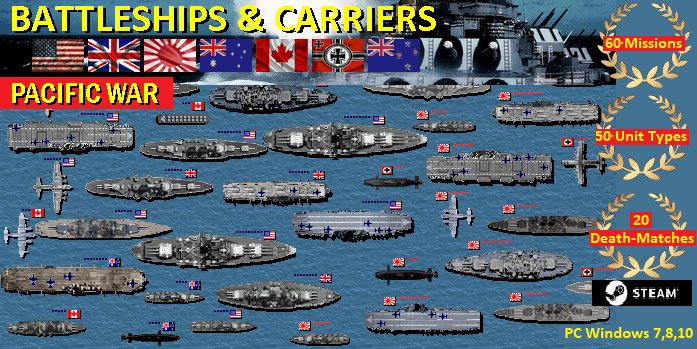T-34 T34
Soviet medium tank
IS-2_Soviet_Tank,
ISU-152,
T-35 Soviet
Heavy Tank
T-55 Tank
T-62 Soviet
Medium Tank,
T80 Main
Battle Tank,
T-90 Main
Battle Tank T-72 Tank
Pre/Post
WW2 USSR Russia Planes - List of Aircraft
Ilyushin_IL2 IL-4_Ilyushin,
Operation
Barbarossa
Zhukov
(Zukov)
MIG19_Farmer
SU35_Sukhoi
SU27_Flanker
SU24_Fencer
MIG21 MIG23_Flogger
MIG25_Foxbat MIG29_Fulcrum
MIG31_Foxhound
Mi24_Hind_Gunship
Ka50_Hokum_helicopter KA25_Kamov_Naval_Helicopter
Kirov_Battlecruiser Kuznetsov_Russian_Aircraft_Carrier
Soviet_Aircraft_Carrier_Varyag
Battleship Game - WW2
Naval Strategy: the best choice among aircraft carrier
games and submarine games.
Missions and Scenarios:
Pearl Harbor Game
Atlantic Game 1943
Sink Cruisers Game
Midway Game
Iwo Jima Game
US Marines Game
Luftwaffe Game Pacific
Torpedo Game Boats
Bismarck Game Pacific
Destroy RAF Game
Okinawa
Us Navy Submarine Game
Fleet Submarines Game
Kamikaze Game
U Boat Game
Singapore Game
Swordfish Hunt
Patrol Boats
Air Supremacy
Alert
Battleships Game
Java
Defense
Fleet Cruisers Game
Atlantic Island
Coral Sea Game
Iron Sea
Mykonos
Imperial Ocean
Long Convoy
Skagerrak
Target Los Angeles
West Pacific Game
Pacific War Game
Leyte Transport
Emperor Hirohito
Normandy Game
South Pacific Game
Destroy USAF Game
Submarine Games
US Navy Game
Free Hunt Doenitz Game
Free Hunt Spruance Game
Free Hunt Halsey Game
Imperial Navy I
Royal Navy Game
Free Hunt Pearl Harbor Games
Midway II
Kriegsmarine I
Brisbane Convoy
Clear West Coast
Fall Of Australia
Battle For Leyte
Conquer Of Japan
HMAS Perth
Road To Okinawa
Orange Ports
Emperor Defense
Prince Of Wales
San Bernardino
Pacific Race
Heavy Duty
Tokio Express
Operation Sidney
Bomber Operation
Conquer Of Italy
Heavy Cruiser Game
Frigate Hunt
Santa Cruz
Lamansh Game
Azores Transport
Norway Convoy
Invasion
Grossadmiral
Norway Ports
Drang Nach Ost
Convoy Pk30
Ciano Defense
Sir John Tovey
Free Hunt Andrews
Germans On Pacific
Silent Hunt
Antigua
Return To Midway
Kriegsmarine Game II
Royal Air Force Game
F. Hunt Lancaster
Jamamoto Game
Free Hunt USN
Free Hunt Japan
Free Hunt RAAF
Free Hunt U Boat Game
Free Hunt Aircraft Carriers Game
Free Hunt Hawaii
Free Hunt Yamato Game
Free Hunt Iwo Jima Game
Free Hunt Pacific Game
Free Hunt Torpedos
Free Hunt Convoy
Free Hunt Germany
Free Hunt Germany II
Free Hunt Italy
Free Hunt Malaya
Free Hunt Subs Game
Free Hunt B-29 Game
Free Hunt USN 1944
Devil Island
Dragoon Carriers
|
Battle of Stalingrad WW2
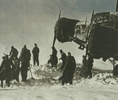
Stalingrad |
|
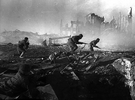
Battle of Stalingrad |
|

Stalingrad |
The Battle of Stalingrad (1942-43) was a major
turning point in World War II. While not Germany's first
setback, it was one of the most important, and one from
which it never fully recovered.
Table of contents
1 Stalingrad Background
2 Stalingrad Operation Blue
3 Stalingrad Rattenkrieg
4 Operation Uranus
5 Operation Neptune
6 The Stalingrad Battle Ends
Stalingrad Battle
Background
The first major military setback for the Third Reich
occurred on the outskirts of Moscow at the end of 1941.
Left in poor defensive positions, the Soviet Union
counter-attacked and drove the Germans back. The reasons
for the scale of the defeat included the Germans' lack of
preparation for the harshness of the Russian winter, the
overextension of their supply lines across their
newly-captured areas, and Hitler's unwillingness to
consider retreat.
As the winter continued the situation for the Germans
improved as more attention was put on equipping them.
Meanwhile newly formed units were being sent forward from
Germany, and by early spring the army should have been
back in fighting condition. Everyone, the Soviets
included, expected them to launch a summer offensive with
another massive attack towards Moscow by the German Army
Group Center.
However the German generals were aware of their weakness
after the losses in front of Moscow, and demanded a more
modest offensive. The Oberkommando der Wehrmacht (OKW)
developed a plan involving Army Group South in an attack
into the Caucasus, cutting Russia in two and capturing
the majority of Soviet oil fields and grain producing
regions. This type of surprise attack over great
distances was the hallmark of the German Blitzkrieg,
which sought to avoid direct battle by attacking where
least expected and then advancing as fast as possible
giving the enemy no chance to plan a defence.
Stalingrad Operation Blue
Their plan, Operation Blue, split Army Group South into
two groups. Army Group A consisted of two armies,
commanded by Erich von Manstein and von Kleist, who were
to attack south towards Rostov, and then fan out through
the Transcaucasus heading for the Caspian Sea while
taking the oil-fields at Maikop. Army Group B included Friedrich
von Paulus's 6th Army and Hoth's 4th Panzer
Army, who would sweep through the corridor between the
Don and Volga rivers to arrive on the Volga just north of
Stalingrad (known today as Volgograd). Their primary task
was to provide a strong northern flank along the Don,
while cutting the vital Soviet freight traffic on the
Volga.
| CIA / KGB intelligence
game. Run your own operation
game. Travel around the world and set up
espionage game, trade with state secrets, weapon
systems, spy codes, WMD, hire secretaries,
agents, lawyers and soldiers, establish secret
agent stations, cells and bases and search for
criminals and politicians. Involve in agent game.
Game contains more than 40 missions including
Nuclear Game, Cold War Game, Secret Agent, CIA
Games, USAF, Prime Minister, RAF, Bin Laden,
Sadam, KGB, Operations Iran… |
|
While the plans were finalized, there remained a threat
from a significant Soviet presence at Sevastopol in the
Crimean. The siege of this important city had been
dragging on for four months at this point, and the
Soviets still had 150,000 men in and around the city.
Eventually Operation Blue was suspended to provide more
troops for the siege, and the original launch date in May
was cancelled. Manstein was sent south with a number of
fresh German and Romanian units under Operation Sturgeon,
and were battle ready by early June. By the end of the
month the siege was over, the Soviets losing all 150,000,
although the German/Romanian side suffered 35,000
casualties as well. The battle was largely over by the
25th, and Operation Blue was implemented.
Commencing on June 28, 1942, the attack started off well.
So well in fact that Hitler felt that the 4th Panzer Army
was not needed with Army Group B, and sent them south to
join Army Group A. By this point they had passed the 6th
Army (as was expected, they were motorized) and had to
cross the 6th's path and march on their way south. The
resulting traffic jam took several days to clear. This
confusion, along with provisions originally intended for
the 6th being given to the 4th instead, slowed the
advance towards Stalingrad by almost two weeks. With the
advance now delayed, Hitler then changed his mind again
and ordered the 4th to rejoin the original line of march.
This delay would prove critical. The slow advance made
the target of Army Group B clear to the Soviets, and gave
Red Army General Andrei Yeremenko time to consolidate
what forces he had into a new line on the eastern bank of
the Volga to block them. He ordered the troops reeling
back from the Germans on the western side to head for
Stalingrad, leaving the field to the Germans. This did
not go unnoticed, as von Weichs, in overall command of
Army Group B, realised that the Soviets had figured out
what was going on. Hitler instead chose to consider the
same reports as proof of absolute victory.
By the end of August, Army Group B had finally reached
the Volga to the north of Stalingrad, before many of the
Red Army troops to their south had. General von Paulus
asked for permission to turn south and take the city as
soon as possible, but Hitler refused to allow this until
his infantry had caught up to form a defensive line. This
delay would also prove critical, as it allowed the Soviet
forces to pour into the city over the next few days,
strengthening its defences.
Stalingrad
Rattenkrieg
Units of the Red Army in Stalingrad were quickly
organized into the new 62nd Army, under the command of
General Lopatin. When Lopatin expressed his fears about
the upcoming battle, Yeremenko immediately replaced him
with Vasily Ivanovich Chuikov, who had previously fought
around Stalingrad against the White Army. Yeremenko
directed Chuikov to hold the city at all costs, and
issued an order similar to Stalin's own, "Not
another step back". Countersigned by Nikita
Khrushchev, this order was backed up with instructions
for the NKVD to shoot anyone who failed to comply.
By September 1st Stalingrad was completely surrounded by
the German 6th Army. Chuikov refused to meet the Germans
outside the city, and had instead set up a huge number of
strongpoints in the houses and factories inside. The
Germans found themselves facing dug-in troops, and the
battle quickly developed into what the Germans referred
to as Rattenkrieg, rat-war. With both sides promoting a
no-retreat, no-surrender policy, intense street fighting
ensued — often descending into hand-to-hand bayonet
struggles — and parts of the city changed hands as
many as three or four times a day.
German tactics during the battle increasingly relied on
air power to block re-enforcements being sent in from the
east side of the river. A running battle started between
the Luftwaffe and the VVS and Soviet anti-aircraft guns.
Although German losses were high, they won control of the
river. The re-enforcement operations simply switched to
moving during the night, thereby eliminating the airborne
threat.
Meanwhile attempts were made to start the ground fight
moving with increasingly heavy artillery barrages,
eventually culminating in the delivery of several
gigantic 600mm German mortars. As time would prove,
however, the Soviets were quick to take up positions in
the resulting rubble.
Although losses were heavy, the 6th Army slowly pushed
the 62nd back to the Volga. Eventually the Soviet forces
were split in two and Chuikov lost communications with
the other half of his army. After another two weeks the
62nd Army consisted of less than a division's worth of
men in a small sliver of land on the southern end of
town, but continued to fight on as hard as ever. The
strain on both commanders was immense: von Paulus
developed an uncontrollable tic in his eye, while Chuikov
was experiencing an outbreak of eczema that required him
to bandage his hands completely.
In Berlin, the situation frustrated Hitler. He became
increasingly convinced that the battle in the city
represented the end of the war itself, and the ability to
claim that they had captured "Stalin's City"
was a victory worth more than the original battle plan.
With grave concerns over the exposed left flank, Franz
Halder, chief of the OKW, continued to express his
misgivings to Hitler. In mid-October 1942, with no
immediate end to the battle in sight, Halder and Hitler
quarrelled for the last time. Hitler dismissed Halder,
replacing him with the more tractable General Kurt
Zeitzler.
Meanwhile the rest of the line was being ignored. While
the possibility of a counterattack along the long
northern flank on the Don had been discussed on several
occasions, Hitler's increasingly irrational orders meant
no defensive work could be carried out. One particular
stretch of the line did not actually run on the Don,
leaving the Red Army several beachheads directly in front
of the Romanian 3rd Army. The 3rd had proven itself in
combat at Sevastopol that summer, but were now stretched
out along 150 km of the front after taking over from
German and Italian units. The Romanian commander had
asked for tanks to clear out the pocket on several
occasions, but in vain. His requests for bulldozers to
cut through the frozen ground and make defensive works
were also refused.
In early November Luftwaffe reconnaissance flights
started showing a massive buildup of Red Army units just
north of the Romanian 3rd Army, preparing for an
offensive on the beachhead. Increasingly desperate
messages dispatched to the OKW from the 6th Army HQ were
ignored, or returned with admonishment about getting on
with the task at hand. Von Paulus eventually gave up
asking and moved the 22nd Panzer Division into position
south of the Romanians. However they arrived in terrible
condition with only 50 serviceable tanks, but were
nevertheless formed up with the only Romanian tank
division to form the newly-named 48th Armoured Corps.
Operation
Uranus
On November 19, 1942 the Red Army unleashed Operation
Uranus. General Vatutin's attacking units consisted of
three complete armies, the 1st Guard, 5th Tank and 21st
Army, including a total of 18 infantry divisions, eight
tank brigades, two motorised brigades, six cavalry
divisions and one antitank brigade. The vast majority of
these units were sent against two points in the Romanian
lines.
The Romanian troops conducted an almost miraculous
defence and managed to hold the line for one day. The
situation was hopeless however, they were outnumbered
some 3 to 1 (almost 7 to 1 in tanks), and had little
modern equipment to face the fresh units being sent in
against them. On the 20th their line had been breached
and huge numbers of Red Army divisions began streaming
south.
Also on the 20th a second attack was launched to the
south of the city against points held by the Romanian 4th
Army, made up primarily of cavalry, and this army
collapsed almost immediately. The Soviet attackers met in
a pincer movement near Kalach two days later, trapping
300,000 Wehrmacht soldiers of the 6th Army and about half
of the 4th Panzer Army in and around Stalingrad, and
shattering both Romanian armies in the process.
Hermann G?ring promised that all the necessary supplies
for the 6th Army could be delivered by the Luftwaffe.
This would allow them to fight on while a ground force
was assembled to re-open the line. If this worked, the
tables could be turned, with the Red Army units on the
"far side" of the Don suddenly surrounded by
troops in the city and newly arriving units from the
west. This strategy had been used to great effect the
year before, but on a much smaller scale and during the
summer. Supplying the 6th Army would require 300 tonnes
to be delivered each day, and by any count the number of
planes needed to achieve this was clearly not available.
However the claim, once stated, could not be withdrawn,
and Adolf Hitler backed G?ring's plan and re-iterated his
order of "no surrender" to his trapped armies.
The supply mission failed almost immediately. The winter
weather offered few occasions when the planes could be
flown in, with one or both ends of the flight-path
covered in clouds and snow. On days with good weather
about 280 tonnes would arrive, but there were only two of
these over the next two months. In general only 1/10th of
the needed supplies were able to be delivered. The supply
planes evacuated sick and wounded Sixth Army soldiers
when taking off from the besieged enclave.
By this point the Red Army had had enough time to set up
defences of their own, and any hope of a forced breakout
by the 6th Army was now futile. Meanwhile the forces that
had not been trapped were desperately setting up a
defensive line along the Don and Chir rivers around 40
miles to the west of the city, organised into the new
Army Group Don with von Manstein in command. Although
they were under constant attack by various Red Army
units, the Soviets did not exploit this opportunity and
focused entirely on taking the city.
By early December 1942 a battlegroup had been formed
southwest of the city from troops withdrawn from the
Caucasus. Although these were excellent troops with an
excellent commander, by this point they were tired and
badly in need of rest and refit. Moreover the majority of
the troops in the Caucasus were left where they were in
order to guard their hard-won advances in the months
prior. Facing this newly-reinforced 4th Panzer Army was
the 2nd Guards Army, one of the Soviet Union's better
units. On 12 December 1942 the Panzers launched their
attack towards Stalingrad, but the attack ran out of
momentum and stalled some 25 kilometers from the city.
The attack was called off on the 23rd. At this point any
hope of rescue was dashed.
Stalingrad -
Operation Neptune
In January the Red Army launched Operation Neptune,
another massive attack from the northern flank, this time
against the Italian 8th Army located just to the west of
the former Romanian positions. Their aim this time was to
drive to Rostov on the Black Sea, thereby cutting off all
of Army Group South.
Hitler continued to make repeated "no retreat"
demands to the troops, and von Manstein grew so tired of
these he eventually demanded to either be left alone or
replaced. Hitler relented, and von Manstein started a
mobile defence using Panzers as "fire brigades"
that would be ordered into holes in the line. The defence
was considerably more successful than might have been
expected given the state of the troops, and the Red Army
was unable to get anywhere near Rostov. Nevertheless
their advance did drive the German lines back further,
and now Stalingrad was some 250 km away.
The Stalingrad
Battle Ends
Realizing all hope was lost, Friedrich von Paulus, in
command of what remained of the 6th Army, started forming
plans for surrender. Realising this, and hoping to rescue
something of the battle, Hitler promoted him to
Field-Marshal on January 30th, 1943. No German
Field-Marshal had ever been taken alive in war, and it
was hoped this would force him to fight on, or take his
own life.
Instead von Paulus saw this as yet another example of
Hitler's increasing irrationality. On January 31, 1943
von Paulus ordered the 6th Army to surrender on February
2 in Stalingrad. A force of 300,000 was now reduced to
only 91,000 tired and starving men. The Soviets
force-marched them to detention camps, many dying of
starvation on the way. Only some 5,000 would return to
Germany after the end of the war.
By any measure the battle of Stalingrad was one of the
bloodiest battles in modern history, with some 300,000
Germans killed or captured. Soviet battle deaths were at
least 400,000, possibly much higher, with more than
100,000 civilians killed in Stalingrad and its suburbs.
No accurate figures have been given for the numbers of
Italian and Romanian soldiers killed in the battle.
The historian William L. Shirer, in his history of World
War II, The Rise and Fall of the Third Reich, summarised
the importance of the Battle of Stalingrad with these
words:
Coupled with El Alamein and the British-American landings
in North Africa it marked the great turning point in
World War II. The high tide of Nazi conquest which had
rolled over most of Europe to the frontier of Asia on the
Volga and in Africa almost to the Nile had now begun to
ebb and it would never flow back again. The time of the
great Nazi blitz offensives, with thousands of tanks and
planes spreading terror in the ranks of the enemy armies
and cutting them to pieces, had come to an end.
Battle of Stalingrad - Order of Battle
German
Sixth Army (von Paulus)
VIII Army Corps (Heitz)
11th Infantry Division (von Armin)
76th Infantry Division (Rodenburg)
XI Army Corps (Strecker)
384th Infantry Division (von Gablenz)
44th (Austrian) Infantry Division (Deboi)
376th Infantry Division (von Daniels)
XIV Panzer Corps (Hube) *
16th Panzer Division (Angern)
3rd Motorised Infantry Division (Schl?mer)
60th Motorised Infantry Division (von Arenstorff-Oyle)
LI Army Corps (von Seydlitz-Kurzbach)
71st Infantry Division (von Hartmann)
79th Infantry Division (von Schwerin)
295th Infantry Division (Korfes)
305th Infantry Division (Steinmetz) including
578th Infantry Regiment - from the northern shores of
Lake Constance which Ludger Fischer tells me means it is
a Swabian unit
389th Infantry Division (Magnus)
100th (Austrian) Jaeger Division (Sanne) including:
Croatian Regiment 369
14th Panzer Division (Kuhn) including
103rd Panzer Grenadier Regiment
24th Panzer Division (von Lenski)
Luftflotte IV
Soviet
64th Army
29th Infantry Division
112th Infantry Division
214th Infantry Division (Biryukov)
229th Infantry Division
783rd Infantry Regiment
804th Infantry Regiment
66th (Motorised) Naval Infantry Brigade
154th (Motorised) Naval Infantry Brigade (Smirnov)
40th Armoured Brigade
137th Armoured Brigade
5 Heavy Tanks
10 T-34
20 T-60
October 1942
From Naval Infantry Brigades, Chuikov (1963), Fowler
(2005), Erickson (1993) and Beevor (1999):
62nd Army (Chuikov)
10th NKVD Rifle Division (Sarayev)
2 x Infantry Brigades
13th Guards Rifle Division (Rodimtsev) - landed 14 Sep
1942 - including:
34th Guards Regiment
39th Guards Regiment
42nd Guards Regiment (Yelin)
35th Guards Rifle Division (Dubyanski)
37th Guards Rifle Division (Zholudev) - landed 2 Oct 1942
- including:
1st Guards Rifle Regiment
114th Guards Rifle Regiment
117th Guards Rifle Regiment (bit confusing, I've got them
in the 39th Guards too.)
Initially without anti-tank guns
39th Guards Rifle Division (Guriev) - landed 30 Sep 1942
- including
117th Guards Rifle Regiment (bit confusing, I've got them
in the 37th Guards too.)
118th Guards Rifle Regiment (probably based on their
fighting on 11 Nov)
Raised from 5th Parachute Corps in Aug 1942.
45th Rifle Division (Sokolov)
95th Rifle Division (Gorishny) including
161st Rifle Regiment
241st Rifle Regiment
At some point sailors from the far east reinforced this
division.
112th Rifle Division (Sologub) including:
416th Rifle Regiment
524th Rifle Regiment
138th Rifle Division (Lyudnikov) including
650th Rifle Regiment
193rd Rifle Division (Smekhotvorov)
685th Rifle Regiment
196th Rifle Division
Comprised mostly of Kazakh, Uzbek and Tartar men.
244th Rifle Division
284th (Siberian) Rifle Division (Batyak) - landed 22 Sep
308th (Siberian) Rifle Division (Gurtiev) - landed 2 Oct
1942 - including
117th Rifle Regiment
84th Tank Brigade - landed 2 Oct 1942
20 T-70s
5 KVs
24 T-34s
137th Tank Brigade
189th Tank Brigade
92nd Naval Infantry Brigade - landed 16 Sep 1942
2 Battalions
42nd Special Brigade (Batrakov)
115th Special Brigade (Andryusenko)
124th Special Brigade (Gorokhov)
140th Special Brigade
160th Special Brigade
Text is available under
the terms of the GNU Free Documentation License
|
Importance of Stalingrad
The capture of Stalingrad was important to Hitler for 2
reasons. First, it was a major industrial city on the
Volga River – a vital transport route between the
Caspian Sea and northern Russia. .
As a result, the German capture of the city would
effectively sever the transportation of resources and
goods to the north. Second, its capture would secure the
left flank of the German armies as they advanced into the
oil-rich Caucasus region – with the strategic goal
of cutting off fuel to Stalin's war machine. The fact
that the city bore the name of the leader of the USSR,
Stalin, would make its capture an ideological and
propaganda coup. The
The Soviets realized this
and, though they were under tremendous constraints of
time and resources, ordered that anyone strong enough to
hold a rifle be sent to defend the city.
The Red Army, at this stage of the war, was less capable
of highly mobile operations than the German Army;
however, the prospect of combat inside a large urban
area, which would be dominated by hand-held small arms
rather than armored and mechanized tactics, minimized the
Red Army's disadvantages.
| |
 |
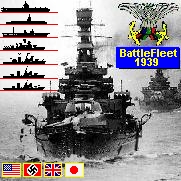 |
| Turn-based WW2
naval game, extension to the classic
Submarine game (Battleship game) where
ships/planes/subs can move. Contains plenty of
game missions, game campaigns and 40 ship,
submarine, airplane ana port artillery types,
with combat maps up to 96X96 large. |
| |
| |
 |
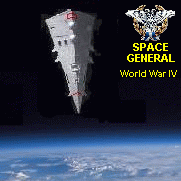 |
Turn-based space
strategy game represents World War 4
conflict on tactical level.
The user-friendly game engine allows more than 60
unit types, including planet battleships, galaxy
cruisers, death-stars, stealth units, star
destroyers, air-space interceptors, explorers,
planet artillery and radars. |
| |
| |
 |
| Tycoon Strategy
Game - build your own world business empire as an
arms dealer tycoon. Travel around the world,
trade with more than 400 weapon systems, hire
secretaries, bodyguards, lawyers, fighters and
tanks, establish companies and search for
criminals and hostages. |
|
|
